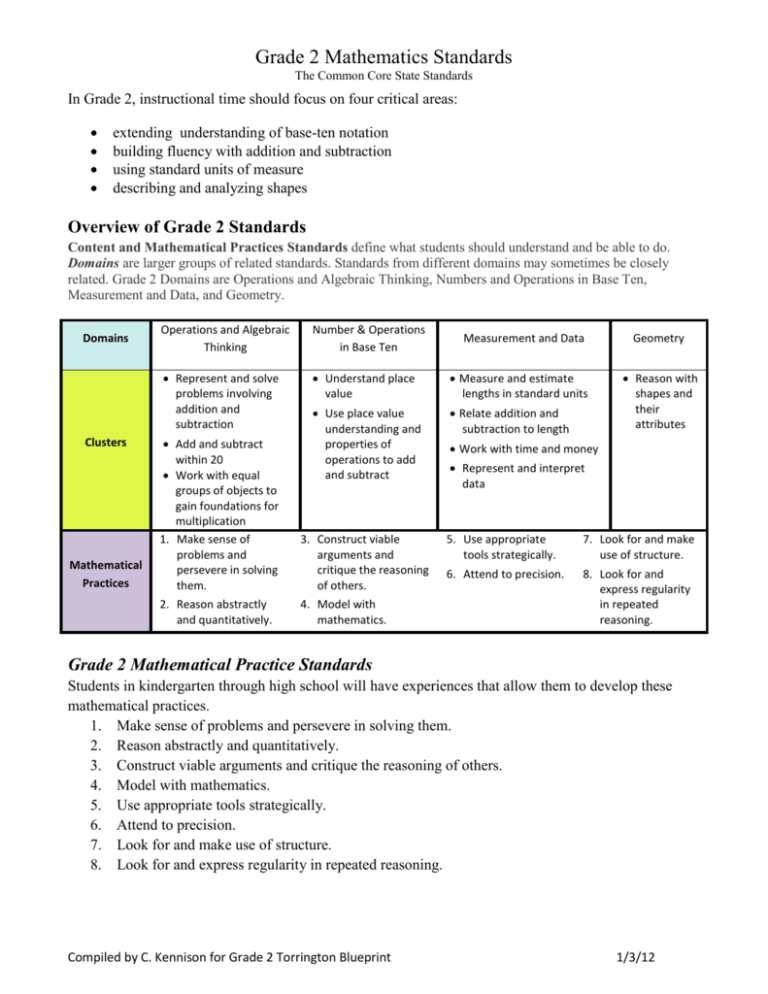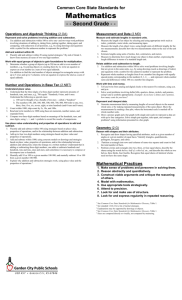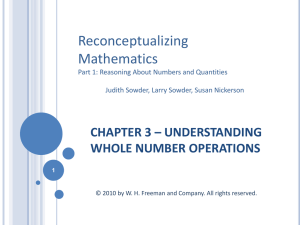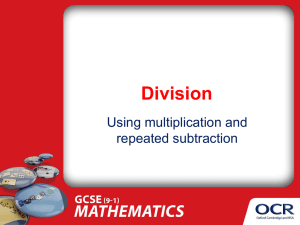Grade 2 Mathematical Practice Standards
advertisement

Grade 2 Mathematics Standards The Common Core State Standards In Grade 2, instructional time should focus on four critical areas: extending understanding of base-ten notation building fluency with addition and subtraction using standard units of measure describing and analyzing shapes Overview of Grade 2 Standards Content and Mathematical Practices Standards define what students should understand and be able to do. Domains are larger groups of related standards. Standards from different domains may sometimes be closely related. Grade 2 Domains are Operations and Algebraic Thinking, Numbers and Operations in Base Ten, Measurement and Data, and Geometry. Domains Clusters Mathematical Practices Operations and Algebraic Thinking Number & Operations in Base Ten Represent and solve problems involving addition and subtraction Understand place value Measure and estimate lengths in standard units Use place value understanding and properties of operations to add and subtract Relate addition and subtraction to length Add and subtract within 20 Work with equal groups of objects to gain foundations for multiplication 1. Make sense of problems and persevere in solving them. 3. Construct viable arguments and critique the reasoning of others. 2. Reason abstractly and quantitatively. 4. Model with mathematics. Measurement and Data Geometry Reason with shapes and their attributes Work with time and money Represent and interpret data 5. Use appropriate tools strategically. 7. Look for and make use of structure. 6. Attend to precision. 8. Look for and express regularity in repeated reasoning. Grade 2 Mathematical Practice Standards Students in kindergarten through high school will have experiences that allow them to develop these mathematical practices. 1. Make sense of problems and persevere in solving them. 2. Reason abstractly and quantitatively. 3. Construct viable arguments and critique the reasoning of others. 4. Model with mathematics. 5. Use appropriate tools strategically. 6. Attend to precision. 7. Look for and make use of structure. 8. Look for and express regularity in repeated reasoning. Compiled by C. Kennison for Grade 2 Torrington Blueprint 1/3/12 Grade 2 Mathematics Standards The Common Core State Standards Grade 2 Content Standards for Mathematics Operations and Algebraic Thinking Represent and solve problems involving addition and subtraction. o Use addition and subtraction within 100 to solve one- and two-step word problems involving situations of putting together, taking apart, and comparing with unknowns in all positions, e.g. by using drawings and equations with a symbol for the unknown number to represent the problem. Add and subtract within 20. o Fluently add and subtract within 20 using mental strategies (Use strategies such as counting on 1 or 2, making 10, decomposing a number leading to 10 (i.e. 13-4 as 13-3 = 10; 10 – 1 = 9), relating addition to subtraction; doubles; near doubles). Automatically know addition and subtraction facts within 20. Work with equal groups of objects to gain foundations for multiplication. o Determine if a group of objects (up to 20) is even or odd by pairing objects or counting by 2s; write an equation to express an even number as a sum of two equal addends. o Use addition to find the total number of objects arranged in rectangular arrays with up to 5 rows and 5 objects in each row; write an equation to express the total as a sum of equal addends. Number and Operations in Base Ten Understand place value. o Understand that the three digits of a three-digit number represent amounts of hundreds, tens, and ones. Count within 1000; skip-count by 5s, 10s, and 100s. Read and write numbers to 100 using numerals, number names, and expanded form. o Compare two three-digit numbers based on the meanings of hundreds, tens, and ones and use symbols <, =, > to record the comparison. Use place value understanding and properties of operations to add and subtract. o Fluently add and subtract within 100 using strategies based on place value, properties of operations, and the relationship between addition and subtraction. Add up to four two-digit numbers using strategies based on place value and properties of operations. Add and subtract within 1000 using concrete models or drawings and strategies based on place value, properties of operations, and the relationship between addition and subtraction. o Relate the strategy to a written method. o Understand that in adding three-digit numbers, one adds hundreds and hundreds, tens and tens and ones and ones; and sometimes it is necessary to compose or decompose tens or hundreds. Mentally add/ subtract 10 or 100 to/from a given number 100 – 900. Explain why addition and subtraction strategies using place value and properties of operations. Compiled by C. Kennison for Grade 2 Torrington Blueprint 1/3/12 Grade 2 Mathematics Standards The Common Core State Standards Measurement and Data Measure and estimate lengths in standard units. o Measure the length of an object by selecting and using appropriate tools (rulers, yardsticks, meter sticks, measuring tapes). o Measure an object twice with units of different lengths and describe how the two measurements relate to the size of the unit chosen. o Estimate lengths using units of inches, feet, centimeters, and meters. o Measure to determine how much longer one object is than another expressing the length difference in terms of a standard length unit. Relate addition and subtraction to length. o Use addition and subtraction within 100 to solve word problems involving lengths that are expressed in the same unit e.g. by using drawings and equations with a symbol for the unknown number to represent the problem. o Represent whole numbers as lengths from 0 on a number line diagram with equally spaced points 0, 1, 2… and represent whole number sums and differences within 100 on a number line. Work with time and money. o Tell and write time from analog and digital clocks to the nearest 5 minutes, using a.m. and p.m. o Solve word problems involving dollar bills, quarters, dines, nickels, and pennies, using the $ and ¢ symbols. Represent and interpret data. o Generate measurement data by measuring lengths of several objects to the nearest whole unit, or by making repeated measurements of the same object. Show the measurements by making a line plot, where the horizontal scale is marked off in whole-number units. o Draw a picture graph and a bar graph (with single-unit scale) to represent up to four categories of data. o Solve simple put together, take apart and comparison problems using information in the graphs. Geometry Reason with shapes and their attributes. o Recognize and draw shapes with specified attributes such as a given number of angles or a given number of equal faces. o Identify triangles, quadrilaterals, pentagons, hexagons, and cubes. Partition a rectangle into rows and columns of same-size squares and count to fine the total number of them. Partition circles and rectangles into two, three, and four equal shares. o Describe the shares using the words halves, thirds, half-of, a third of, etc. o Describe the wholes as two halves, three thirds, four fourths. o Recognize that equal shares of identical wholes need not have the same shape. Compiled by C. Kennison for Grade 2 Torrington Blueprint 1/3/12 Grade 2 Mathematics Standards The Common Core State Standards Common Teaching and Learning Resources Growing with Mathematics Teaching Student-Centered Mathematics, K-3 MathLand Grade 2 Math Work Stations Mastering the Basic Math Facts in Addition and Subtraction Current Common District Assessments Adding and Subtraction 2-Digit Numbers, GWM Topic 5, Check-up B (Numbers 4 and 5) Addition and Subtraction Fact Assessments Comprehensive Assessment Compiled by C. Kennison for Grade 2 Torrington Blueprint 1/3/12









